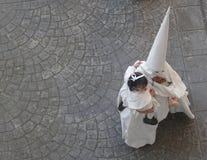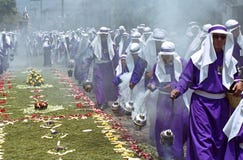Holy Week In Guatemala: Jesus Nazarene Of Miracles, The Longest Running And Most Traditional Procession In The City. The Procession Of Jesus Nazarene Of Miracles From The Church Of Saint Joseph Occurs Every Palm Sunday. The Image Was Donated To The Church In 1736, And A Brotherhood Was Founded. It Was Transferred From Antigua Guatemala To Guatemala City, After The Santa Marta Earthquakes Between 1773 And 1776. This Image Has Anatomically Perfect Facial Features In A Carved Wooden Image. Earthquakes At The Beginning Of The 20Th Century Destroyed The Temple, And The Reconstructed Structure Was Destroyed Again By The Earthquake Of 1976. Several People Risked Their Lives To Extract The Image From Among The Ruins. In 1993, The Image Was Consecrated And Crowned. In 1996 It Was Proclaimed Perpetual Protector Of The City Of Antigua Guatemala. The Procession Is One Of The Most Traditional And Longest Running During Holy Week. It Leaves The Small Temple At 6:30 A.m. And Returns On Holy Monday At 1:30 A.m. One Of Its Characteristics Is That It Is Accompanied Throughout Its Journey By A Squad Of Penitents Dressed As Roman Soldiers. Holy Week Is The Celebration Of The Passion And Death Of Christ, Through The Processions Carried Out By The Brotherhoods Of All Parishes, Between Palm And Easter Sunday, Usually At The End Of March And Beginning Of April. Processions Are Characterized By Colorful Sawdust Carpets That Adorn The Streets, And Images Of Jesus And Mary Carried On Shoulders By Large Congregations For Long Periods Of Time. The Covid-19 Pandemic Forced The Suspension Of Processions For Two Years.
ID 268226974 © Cduartefoto | Megapixl.com
Sharing is not just caring, it's also about giving credit - add this image to your page and give credit to the talented photographer who captured it.:
KEYWORDS
anatomically antigua april brotherhood carpets carved century christ church city colorful congregations consecrated country death destroyed donated dressed earthquakes easter facial features founded guatemala holy image jesus joseph journey large longest march marta mary miracles monday nazarene palm passion penitents people perfect perpetual procession protector roman running saint santa sawdust soldiers squad structure sunday temple traditional week wooden













































